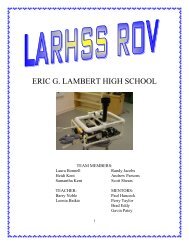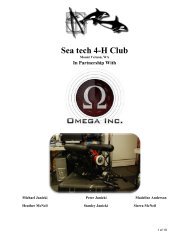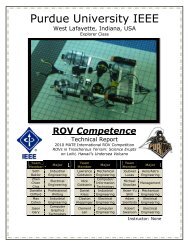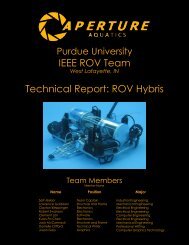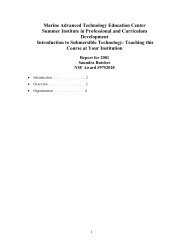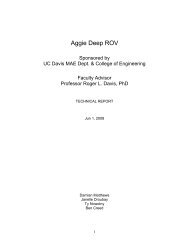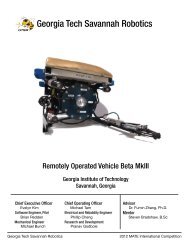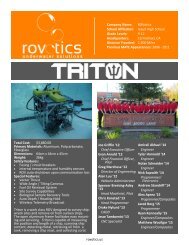technical report - the Marine Advanced Technology Education (MATE)
technical report - the Marine Advanced Technology Education (MATE)
technical report - the Marine Advanced Technology Education (MATE)
Create successful ePaper yourself
Turn your PDF publications into a flip-book with our unique Google optimized e-Paper software.
This year <strong>the</strong>re have been many<br />
<strong>technical</strong> problems. One of <strong>the</strong> competition<br />
tasks was <strong>the</strong> identification of metallic and<br />
nonmetallic debris on <strong>the</strong> site of <strong>the</strong><br />
shipwreck. We’ve boldly imagined<br />
ourselves as entrepreneurs of a virtual<br />
trading company UWIS-Underwater<br />
innovation systems. For metal detection<br />
tasks, we decided to develop a portable<br />
metal detector (Minelab type). We generally<br />
designed a retractable system, thought out<br />
its sealing, began to study <strong>the</strong> processing of<br />
signals, but <strong>the</strong>n encountered a strong<br />
induction of <strong>the</strong> interference from <strong>the</strong><br />
vehicle to metal detector and vice versa. We<br />
also underestimate <strong>the</strong> problem of limited<br />
space for <strong>the</strong> installation such voluminous<br />
device as metal detector.<br />
We had to put in place a simpler<br />
fluxgate device. Its capacity is sufficient for<br />
performing competitive tasks and to<br />
determine <strong>the</strong> nature of debris.<br />
The non-<strong>technical</strong> challenge that<br />
arose before <strong>the</strong> team was an effective<br />
communication with foreign colleagues.<br />
Last year we lost some points in <strong>the</strong><br />
competition because of <strong>the</strong> lack of expertise<br />
in translating <strong>technical</strong> documents. The<br />
mentor of <strong>the</strong> team, Stanislav Severov,<br />
identified five students, who took English<br />
courses to improve <strong>the</strong>ir knowledge of<br />
<strong>technical</strong> English. The BMSTU team also<br />
used <strong>the</strong> “Underwater Robotics: Science,<br />
Design & Fabrication” book, written by Dr .<br />
Steven W. Moore, Harry Bohm, and Vickie<br />
Jensen.” This book was indispensable in<br />
getting acquainted with <strong>the</strong> correct<br />
terminology in <strong>the</strong> field of underwater<br />
robotics. We are thankful to its authors.<br />
Our team reviewed a number of<br />
decisions taken in <strong>the</strong> design of <strong>the</strong> ROV’s<br />
devices this year, and made appropriate<br />
conclusions.<br />
We realized that electronics case<br />
should be placed vertically thus leaving<br />
free space for special equipment. In our<br />
present ROV, electronics case is positioned<br />
horizontally. It takes a lot of space on <strong>the</strong><br />
bottom of <strong>the</strong> frame and creates difficulties<br />
for <strong>the</strong> placement of devices.<br />
In <strong>the</strong> future we plan to make a<br />
symmetrical design, i.e. cameras, lights<br />
and devices will be located on both front<br />
and rear of ROV. The cameras will be<br />
placed in separate sealed cases, as it is<br />
done on <strong>the</strong> industrial ROVs.<br />
We also plan to remove <strong>the</strong> servo<br />
machines, used in manipulator system,<br />
and build a complete hydraulic system.<br />
17



